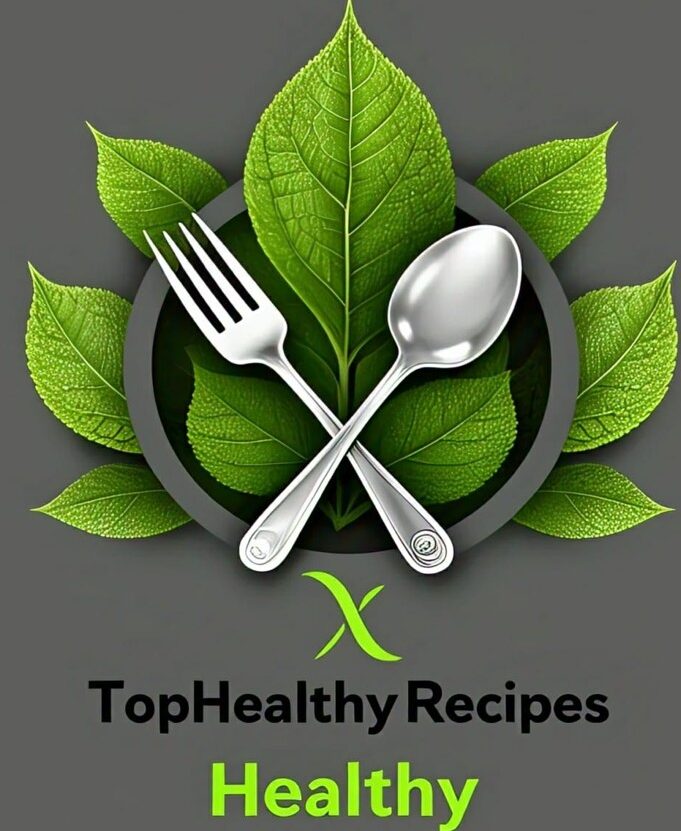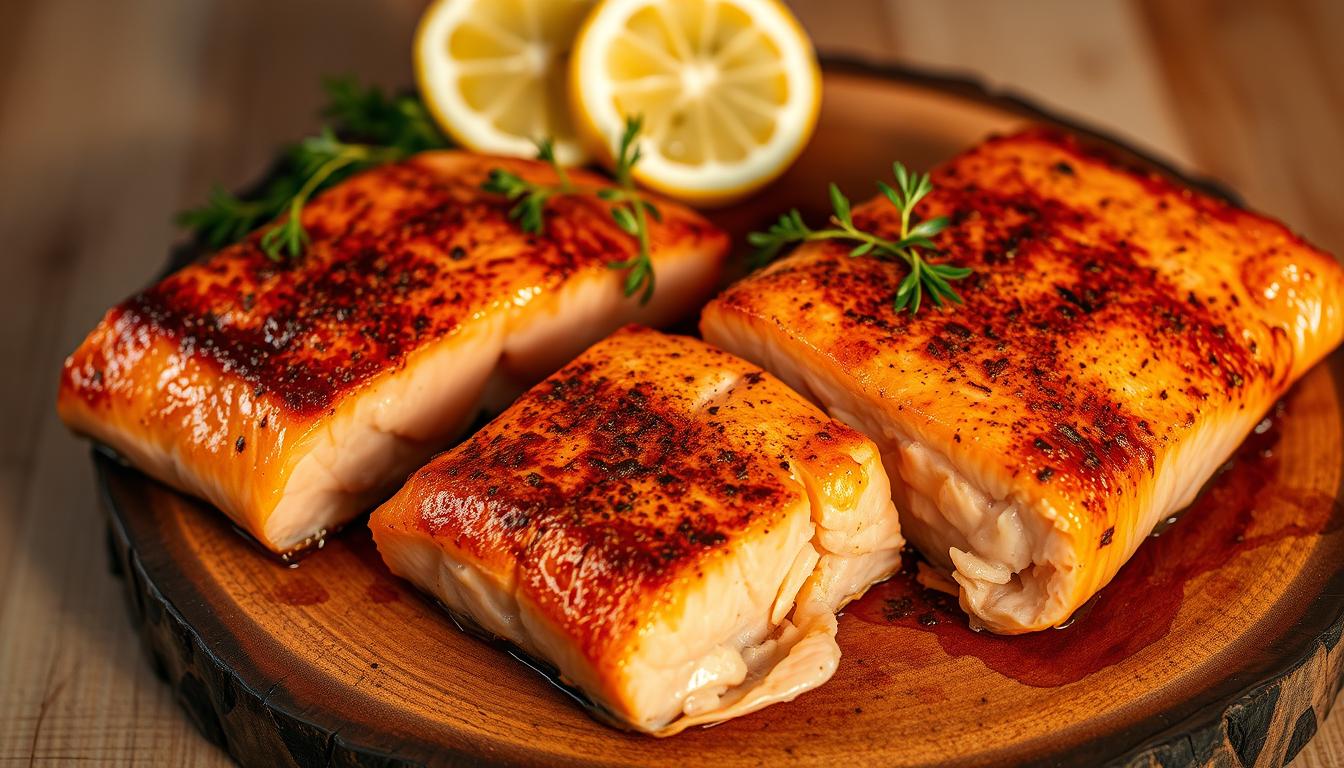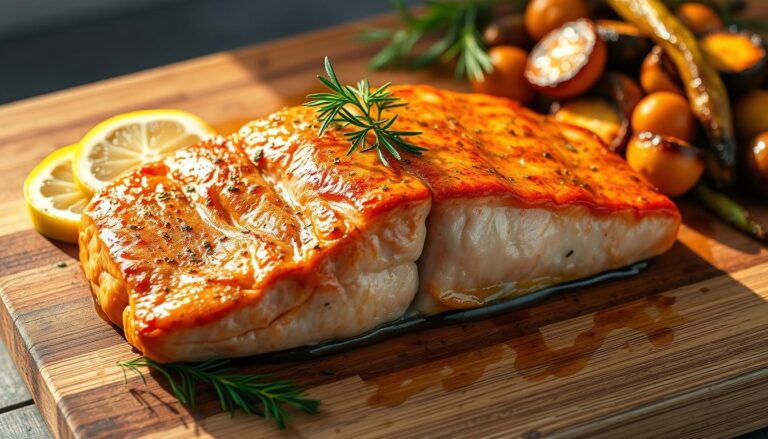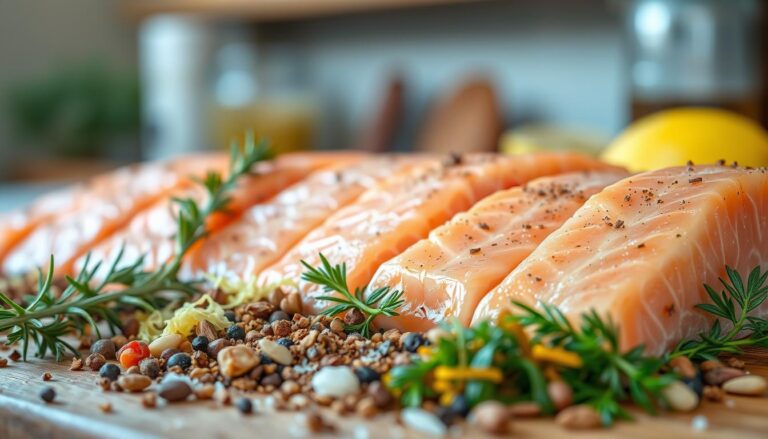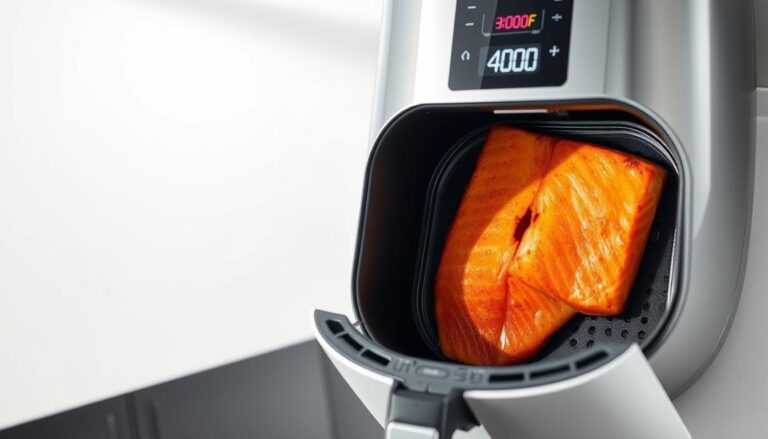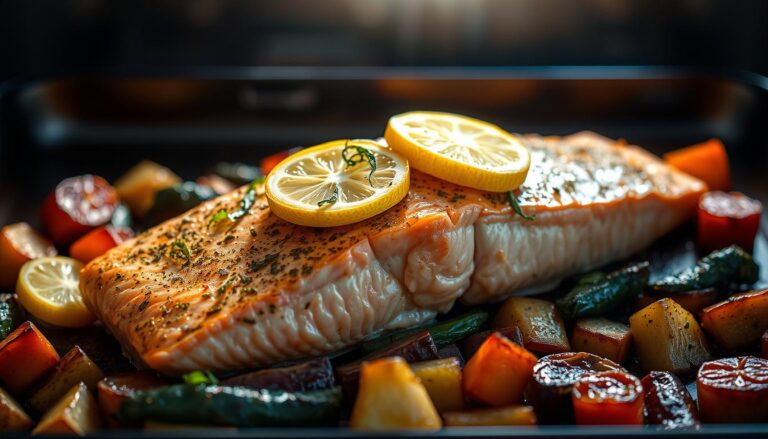Baked salmon temp for perfect doneness
Table of Contents
Baked salmon temp for perfect doneness
Cooking fish to perfection requires precision, especially when it comes to temperature. Whether you’re preparing a 2-pound fillet or smaller portions, the right oven setting ensures moist, flaky results. Overcooking can dry out your dish, while undercooking may compromise safety.
For a 2-pound piece, 375°F is ideal, cooking for 15-20 minutes. Smaller 6-ounce fillets work best at 400-425°F for 12-14 minutes. Wild-caught fish tends to cook faster than farmed due to its thinner texture. Always aim for an internal temperature of 145°F, as recommended by the FDA.
Using the right herbs and spices can elevate your recipe, but the oven’s heat is the real star. Avoid common mistakes like cranking up the heat too high, which can lead to uneven cooking. With these tips, you’ll master the art of preparing fish every time.
Key Takeaways
- Precise temperature control ensures moist, flaky results.
- Cook a 2-pound fillet at 375°F for 15-20 minutes.
- Smaller fillets need 400-425°F for 12-14 minutes.
- Wild-caught fish cooks faster than farmed.
- Always reach an internal temperature of 145°F for safety.
Introduction to Baked Salmon
Looking for a quick and healthy dinner option? Try this easy recipe. With just five ingredients and a 5-minute prep time, you can create a flavorful dish that’s perfect for any weeknight. Whether you’re cooking for one or feeding a crowd, this method ensures a moist and delicious meal every time.
Using foil or parchment paper is the secret to keeping your fish tender and juicy. This technique locks in moisture, preventing the dish from drying out. It’s a simple yet effective way to achieve restaurant-quality results at home.
This recipe has gained immense popularity, with over 2 million views and glowing reviews. Many home cooks have shared their success stories, transitioning from hesitant beginners to confident fish enthusiasts. The simplicity of the required tools and ingredients makes it accessible for everyone.
Here’s a quick comparison of why this method stands out:
| Method | Prep Time | Moisture Retention | Nutritional Benefits |
|---|---|---|---|
| Baked with Foil/Parchment | 5 minutes | High | Lower fat content |
| Pan-Fried | 10 minutes | Moderate | Higher fat content |
This approach not only saves time but also offers a healthier alternative to traditional frying. It’s a versatile recipe that can be customized with your favorite herbs and spices, making it a go-to option for any occasion.
Why Temperature Matters for Baked Salmon
Mastering the art of cooking fish starts with understanding the role of temperature. The heat in your oven directly affects the texture and safety of your dish. Too high, and you risk drying out the fish or causing excessive albumin, a white protein that oozes out when the heat is too intense.
At 375°F, thick cuts remain moist and tender. This moderate heat prevents the muscle fibers from tightening too much, ensuring a flaky texture. On the other hand, 400°F can trigger albumin coagulation, leading to a less appealing appearance and rubbery consistency.
Resting your fish after cooking is equally important. Carryover cooking raises the internal temperature by 5-7°F, ensuring doneness without overcooking. This step also helps preserve the omega-3 fatty acids, which are sensitive to high heat.
Here’s a quick comparison of how different materials affect cooking:
| Material | Thermal Conductivity | Moisture Retention |
|---|---|---|
| Foil | High | Excellent |
| Parchment | Moderate | Good |
Following USDA guidelines, always aim for an internal temperature of 145°F. This ensures safety while maintaining the delicate balance of flavor and texture. By understanding the science behind temperature, you can elevate your cooking skills and enjoy perfectly prepared fish every time.
Choosing the Right Salmon for Baking
Selecting the right type of fish can make or break your dish. The quality of your meal starts with choosing the best ingredients. Whether you prefer wild or farmed, the cut and freshness matter.
Wild sockeye and coho are leaner and cook faster due to their thinner texture. Farmed Atlantic, on the other hand, is thicker and richer in fat, making it more forgiving during cooking. Skin-on cuts are ideal as they protect the flesh and retain moisture.
When shopping, look for bright eyes and firm flesh to ensure freshness. Center-cut fillets are preferred for even cooking, with an optimal thickness of 1-1.5 inches. If you’re unsure, ask your fishmonger to remove the skin or portion it for you.
Here’s a quick comparison of wild and farmed fish:
| Type | Texture | Fat Content | Cooking Time |
|---|---|---|---|
| Wild Sockeye/Coho | Lean | Low | Faster |
| Farmed Atlantic | Thick | High | Slower |
For sustainability, look for MSC-certified options. Frozen fish can be a great alternative if fresh isn’t available. Just thaw it properly before cooking to maintain its texture and flavor.
Portion sizing is also key. Aim for 6-8 ounces per serving to ensure everyone gets a satisfying meal. With these tips, you’ll be ready to create a dish that’s both delicious and perfectly cooked.
Essential Ingredients for Baked Salmon
The right ingredients can transform a simple dish into a culinary masterpiece. When preparing fish, the quality and combination of components play a crucial role in achieving the perfect flavor and texture.
Start with the basics: olive oil, fresh lemon, minced garlic, and a sprinkle of salt and pepper. These core elements enhance the natural taste of the fish without overpowering it. For added richness, consider using butter or a drizzle of pesto.
When selecting oils, extra virgin olive oil (EVOO) is a popular choice for its robust flavor. Avocado oil and ghee are excellent alternatives, offering unique profiles and higher smoke points. Citrus options like lime or orange can also add a refreshing twist to your recipe.
Fresh herbs are a must. Avoid dried varieties for the best results. Pair dill with lemon for a classic combination, or use rosemary and garlic for a more savory profile. Always look for vibrant, aromatic herbs to ensure freshness.
Here’s a quick guide to salt types:
- Kosher salt: Ideal for even seasoning.
- Sea salt: Adds a subtle crunch and mineral flavor.
- Table salt: Fine-grained and highly concentrated.
For those following dietary restrictions, dairy-free options like coconut oil or nut-based pesto work beautifully. Whole30-compliant ingredients ensure your dish meets specific nutritional guidelines without compromising taste.
By focusing on these essential ingredients, you can create a dish that’s both delicious and perfectly balanced. Whether you’re a seasoned cook or a beginner, these tips will help you elevate your culinary skills.
Preparing Your Salmon for Baking
Achieving the perfect dish starts with proper preparation. Whether you’re a seasoned cook or a beginner, the way you handle your ingredients can make all the difference. From seasoning to wrapping, each step ensures a flavorful and moist result.
How to Season Your Salmon
Seasoning is key to enhancing the natural flavors of your dish. Start with a light coating of olive oil to keep the fish moist. Sprinkle salt evenly for balanced seasoning. For a deeper flavor, consider dry brining by letting the fish sit with salt for 30 minutes before cooking.
Herbs and citrus add a refreshing twist. Use chopped dill or parsley for a fresh aroma. Place lemon slices under or over the fish for a zesty infusion. If you prefer a savory profile, minced garlic works wonders. Whole herbs can also be used for a more subtle flavor.
Using Foil or Parchment Paper
Wrapping your fish in foil or parchment paper locks in moisture and prevents sticking. Foil packets are easy to fold and create a sealed environment for even cooking. Parchment paper, on the other hand, is a great non-stick option and allows for a slightly crispier texture.
To fold a foil packet, place the fish in the center and bring the edges together. Crimp the sides tightly to seal. For parchment, create a pouch by folding the edges and securing them with a small fold. Both methods ensure a juicy and tender result.
Let your fish rest at room temperature for 10-15 minutes before cooking. This step ensures even heat distribution and prevents overcooking. With these tips, you’ll be ready to create a dish that’s both delicious and perfectly prepared.
Optimal Baked Salmon Temp and Cooking Time
Understanding the right heat and timing is crucial for a flawless dish. Whether you’re preparing a large side or individual fillets, the temperature and time in the oven directly impact the texture and safety of your meal. Let’s break down the specifics to help you achieve perfect results every time.
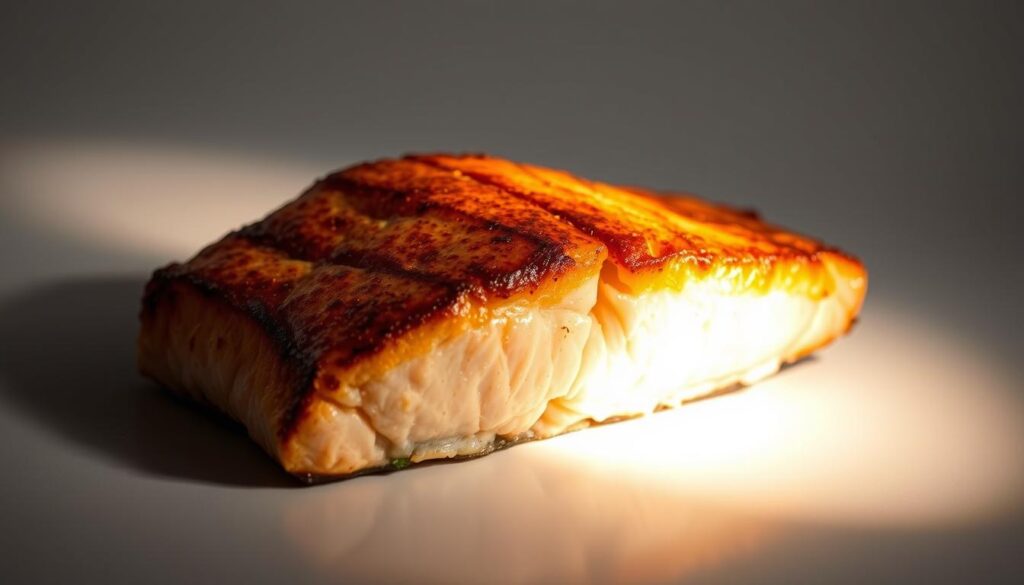
Cooking Times for Different Salmon Sizes
The size of your fillet or steak determines the ideal cooking duration. Here’s a quick guide to help you plan:
- 2-pound side: Cook at 375°F for 15-20 minutes.
- 6-ounce fillet: Bake at 400°F for 12-14 minutes.
- 1-inch fillet: Requires 14-16 minutes at 375°F.
- 1.5-inch steak: Needs 18-22 minutes at the same temperature.
- Whole side (3 pounds): Cook for 25-28 minutes at 375°F.
For a crisp finish, broil the dish for the last 2-3 minutes. Always check the thickest part with a thermometer to ensure it reaches 145°F.
Additional Considerations
Here are some factors to keep in mind for optimal results:
- Altitude: At higher elevations, increase cooking time by 5-10% due to lower air pressure.
- Convection vs. Conventional Oven: Convection ovens cook faster and more evenly. Reduce the temperature by 25°F or shorten the time by 10-15%.
- Visual Indicators: The flesh should turn opaque and flake easily with a fork. Avoid overcooking to maintain moisture.
By following these guidelines, you’ll master the art of preparing a perfectly cooked dish. Whether you’re a beginner or an experienced cook, these tips ensure consistent results every time.
How to Check if Your Salmon is Done
Ensuring your dish is perfectly cooked requires accurate testing methods. Whether you’re a beginner or an experienced cook, knowing how to verify doneness is essential for safety and quality. The FDA recommends an internal temperature of 145°F for cooked fish. However, removing it from the oven at 135-140°F allows for carryover cooking during resting.
Using a Thermometer for Perfect Doneness
An instant-read or probe thermometer is the most reliable tool for checking doneness. Insert it into the thickest part of the fillet, avoiding bones for an accurate reading. Calibrate your thermometer using the ice water test to ensure precision. Here’s how to use it effectively:
- Insert at a slight angle for consistent results.
- Check multiple points to confirm even cooking.
- Clean the probe after each use to maintain hygiene.
For rare to well-done preferences, target these ranges:
- Rare: 120-125°F (remove at 115-120°F).
- Medium: 130-135°F (remove at 125-130°F).
- Well-done: 145°F (remove at 135-140°F).
The Flake Test: A Simple Alternative
If you don’t have a thermometer, the flake test is a quick alternative. Gently press a fork into the thickest part of the fillet. If the flesh separates easily into flakes, it’s done. While this method is convenient, it’s less precise than using a thermometer.
Remember, resting your dish for 5-10 minutes allows the internal temperature to rise by 5-7°F. This step ensures even cooking and preserves moisture. By mastering these techniques, you’ll confidently prepare a perfectly cooked meal every time.
Variations of Baked Salmon Recipes
Exploring different ways to prepare your dish can add variety to your meals. Whether you prefer zesty citrus flavors or rich, savory notes, these recipes offer something for everyone. Let’s dive into two popular variations that are easy to make and packed with flavor.
Baked Salmon with Lemon and Dill
This classic combination brings a refreshing twist to your dish. Start with fresh dill and lemon zest for the best results. Here’s how to make it:
- Use 2 tablespoons of fresh dill for a vibrant aroma.
- Slice lemons thinly or juice them for a tangy flavor.
- Pair with a caper cream sauce for added richness.
- Serve with a glass of white wine for a perfect meal.
Fresh dill should have bright green leaves and a strong scent. Avoid wilted or yellowing herbs for the best taste.
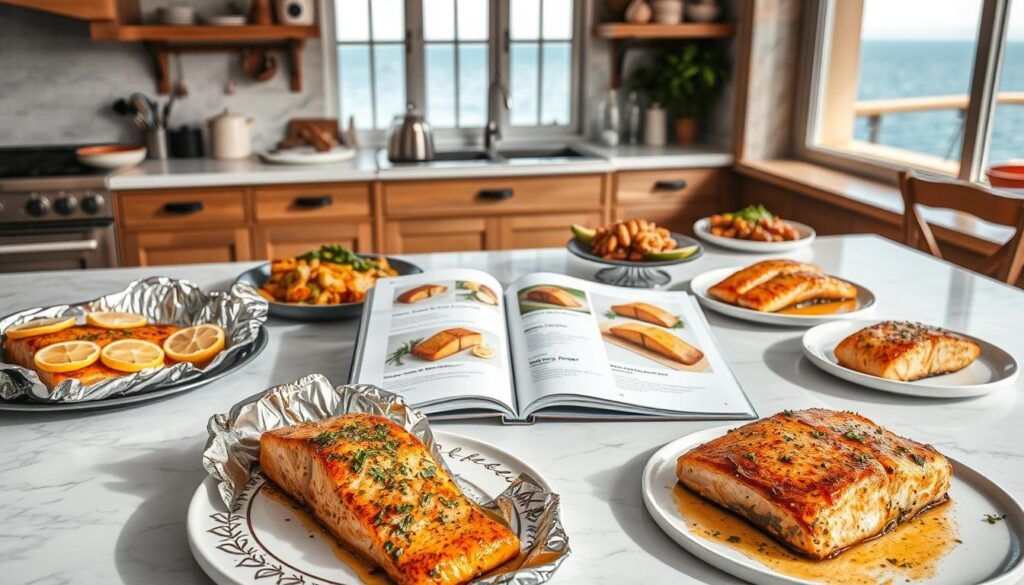
Garlic Butter Baked Salmon
For a richer flavor, try this garlic butter recipe. It’s simple yet indulgent. Here’s what you’ll need:
- 3 cloves of minced garlic for a robust taste.
- 4 tablespoons of butter to create a smooth, rich sauce.
- Add a sprinkle of parsley for a fresh finish.
This recipe is perfect for those who love bold flavors. The butter enhances the natural richness of the dish, while the garlic adds depth.
For a pesto variation, mix in ¼ cup of basil pesto. It’s a quick way to add a herby, nutty flavor to your meal. These recipes are versatile and can be customized to suit your taste.
Serving and Pairing Suggestions
Elevate your meal with thoughtful pairings and presentation. The right sides and sauces can transform your dish into a feast. Whether you’re hosting a dinner party or enjoying a family meal, these tips will help you create a memorable experience.
Start with a refreshing quinoa and arugula salad. The nutty flavor of quinoa pairs perfectly with the peppery arugula, adding a light and healthy touch to your plate. For a zesty finish, garnish with a lemon wedge. This simple addition enhances the flavor and adds a pop of color.
When it comes to wine, Sauvignon Blanc and Pinot Noir are excellent choices. Sauvignon Blanc complements the citrus notes, while Pinot Noir adds depth to richer preparations. These pairings ensure a balanced and enjoyable meal.
For plating, consider aesthetics. Arrange your dish with care, using fresh herbs as a garnish. Dill or parsley can add a vibrant touch. If you’re entertaining, individual plating creates an elegant presentation. For family-style meals, serve in a large dish for a cozy, shared experience.
Enhance your meal with a variety of sauces. Hollandaise and beurre blanc are classic options that add richness. For a lighter alternative, try a lemon-dill sauce. These sauces elevate the flavor without overpowering the main ingredient.
Starch pairings like dill potatoes or wild rice provide a satisfying base. Roasted broccolini or asparagus adds a fresh, crunchy contrast. These sides complete the meal and ensure a well-rounded dining experience.
For allergen-friendly adaptations, use dairy-free sauces or gluten-free grains. These adjustments make your meal accessible to everyone. With these suggestions, you’ll create a dinner that’s both delicious and visually appealing.
Storing and Reheating Leftover Baked Salmon
Properly storing and reheating your leftovers ensures they stay fresh and flavorful. Whether you’re meal prepping or saving extras, these tips will help you enjoy your dish safely and deliciously.
Store your leftovers in an airtight container in the fridge for up to 2 days. Always let your meal cool to room temperature before sealing it. This prevents condensation, which can affect texture and taste.
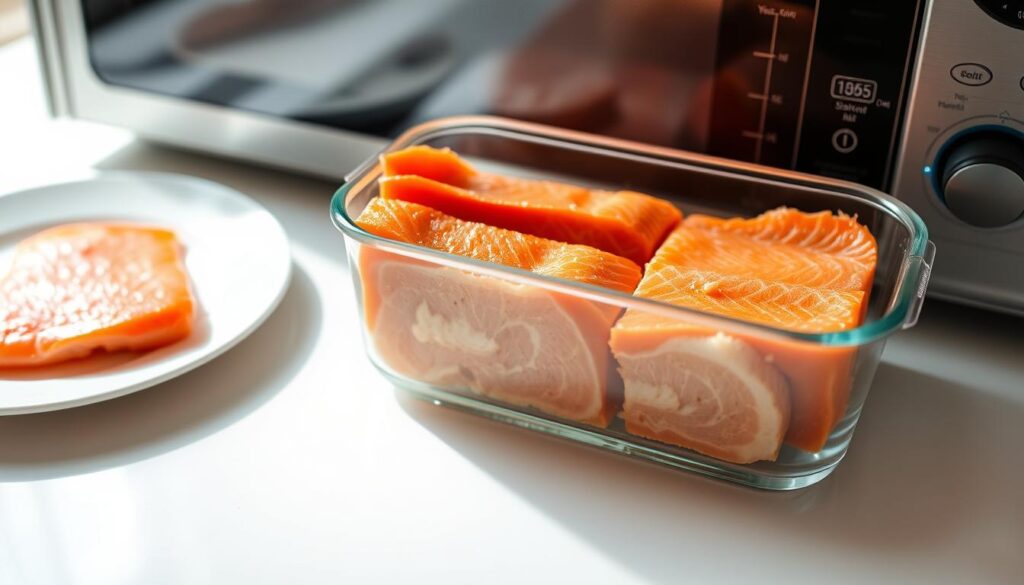
For reheating, the skillet steam method works wonders. Add a splash of water or broth to the pan, cover, and heat on low. This keeps the fish moist and prevents drying out. Alternatively, use the microwave at 50% power in short intervals, checking frequently to avoid overcooking.
If you’re freezing leftovers, portion them into single servings. While freezing can alter the texture slightly, it’s a great way to extend shelf life. Thaw in the fridge overnight before reheating.
To revitalize dried leftovers, try flaking them into a salad or mixing them into patties for salmon cakes. Always check the internal temperature reaches 145°F for safety.
By following these steps, you can make the most of your recipe and enjoy it within two days or beyond. Proper storage and reheating techniques ensure every bite is as good as the first.
Health Benefits of Baked Salmon
Including fish in your diet offers a range of health advantages that go beyond taste. Rich in essential nutrients, it supports overall well-being and can be a cornerstone of a healthy lifestyle. Whether you’re looking to improve your heart health or boost brain function, fish delivers remarkable benefits.
A 5-ounce serving of fish provides 28 grams of protein, making it an excellent choice for muscle repair and growth. It also contains 67% of the recommended daily intake of selenium, a mineral that supports immune function and thyroid health. These nutrients make fish a powerhouse for maintaining your body’s systems.
One of the standout features of fish is its high omega-3 content. With 2,260 milligrams per portion, these fatty acids are essential for reducing inflammation and supporting cardiovascular health. Studies show that regular consumption can lower the risk of heart disease and improve cholesterol levels.
Fish is also linked to enhanced cognitive function, thanks to its omega-3 fatty acids. These nutrients support brain health, improving memory and reducing the risk of cognitive decline. Additionally, its anti-inflammatory properties can alleviate conditions like arthritis and promote joint health.
Other notable benefits include its vitamin D content, which aids in calcium absorption and bone health. It also supports muscle recovery after exercise and contributes to glowing skin by maintaining hydration and elasticity. When it comes to safety, fish has low mercury levels, making it a safe choice for regular consumption.
By incorporating fish into your meals, you’re not just enjoying a delicious dish—you’re investing in your long-term health. Its nutrient profile makes it a versatile and essential part of a balanced diet.
Conclusion
Perfecting your dish is easier than you think. With a recipe that takes less than 30 minutes, you can create a flavorful meal for any weeknight. Whether you’re new to cooking or a seasoned pro, this method ensures success every time.
Remember, the right way to prepare your salmon involves precise timing and temperature. Experiment with herbs, spices, and sauces to make it your own. This dish is versatile, pairing well with salads, grains, or roasted veggies.
Don’t forget the health benefits. Packed with protein and omega-3s, bake salmon is a nutritious choice for any dinner. Share your experience by leaving a review or tagging us on social media. Your feedback helps others discover this amazing recipe!
FAQ
What is the best temperature for baking salmon?
How long should I bake salmon?
Should I use foil or parchment paper when baking salmon?
How do I know when my salmon is done?
What are some simple seasonings for baked salmon?
Can I prepare baked salmon ahead of time?
What sides pair well with baked salmon?
How do I store and reheat leftover baked salmon?
What are the health benefits of baked salmon?
Can I use frozen salmon for baking?
For more cooking tips, stay connected with us. We also recommend the cookbook Skinnytaste Simple: Easy, Healthy Recipes with 7 Ingredients or Fewer
For more Recipes about Salmon
